| B. Sc. Lukas Ahlheit | |||||||
|
Publications(up to 2022)
-
Raman imaging of atoms inside a high-bandwidth cavity, Phys. Rev. A 105, 043321 (2022)arXivBibTeX ABSTRACT »
ABSTRACT »High-bandwidth, fiber-based optical cavities are a promising building block for future quantum networks. They are used to resonantly couple stationary qubits such as single or multiple atoms with photons routing quantum information into a fiber network at high rates. In high-bandwidth cavities, standard fluorescence imaging on the atom-cavity resonance line for controlling atom positions is impaired since the Purcell effect strongly suppresses all-directional fluorescence. Here, we restore imaging of 87Rb atoms strongly coupled to such a fiber Fabry-Pérot cavity by detecting the repumper fluorescence which is generated by continuous and three-dimensional Raman sideband cooling. We have carried out a detailed spectroscopic investigation of the repumper-induced differential light shifts affecting the Raman resonance, dependent on intensity and detuning. Our analysis identifies a compromise regime between imaging signal-to-noise ratio and survival rate, where physical insight into the role of dipole-force fluctuations in the heating dynamics of trapped atoms is gained.
-
Preparation of Small Atomic Ensembles in a Fiber Cavity, (2020), MasterarbeitBibTeX ABSTRACT »
ABSTRACT »In this work, I report on the imaging and preparation of small atomic ensembles inside our fiber cavity. In Chapter 2, non-destructive techniques for determining the number of atoms loaded into the mode of the cavity are presented. Fluorescence images obtained via Raman cooling imaging [35] are analyzed by means of atom position determination and fluorescence integration. Furthermore, a non-invasive and resource-efficient multi-atom loading technique, based on atom accumulation at the orthogonal lattice crossing under continuous transport, is proposed. The method is studied by a classical 1D numerical simulation in Chapter 3, to explore the parameter space and dynamics of this loading technique. In Chapter 4, the implementation of the novel loading technique is explained and measurement results are compared to the numerical findings. Finally, it is compared to two alternative loading methods and their spatial loading distributions are analyzed. The Appendix presents the procedure for the interferometric alignment of the focal points of the four aspheric lenses used to focus the dipole trap beams and to image the trapped atoms.
-
Frequenzvariable Phasenstabilisierung eines Diodenlasers auf einen optischen Frequenzkamm, (2017), BachelorarbeitBibTeX
Forschungsgebiete
Unsere Gruppe
Veröffentlichungen
Abgeschlossene Projekte
Lehre
Weitere Informationen
Anmeldung
Vorträge
- Curtius Lectures
- 03/05/22 - 06/05/22










